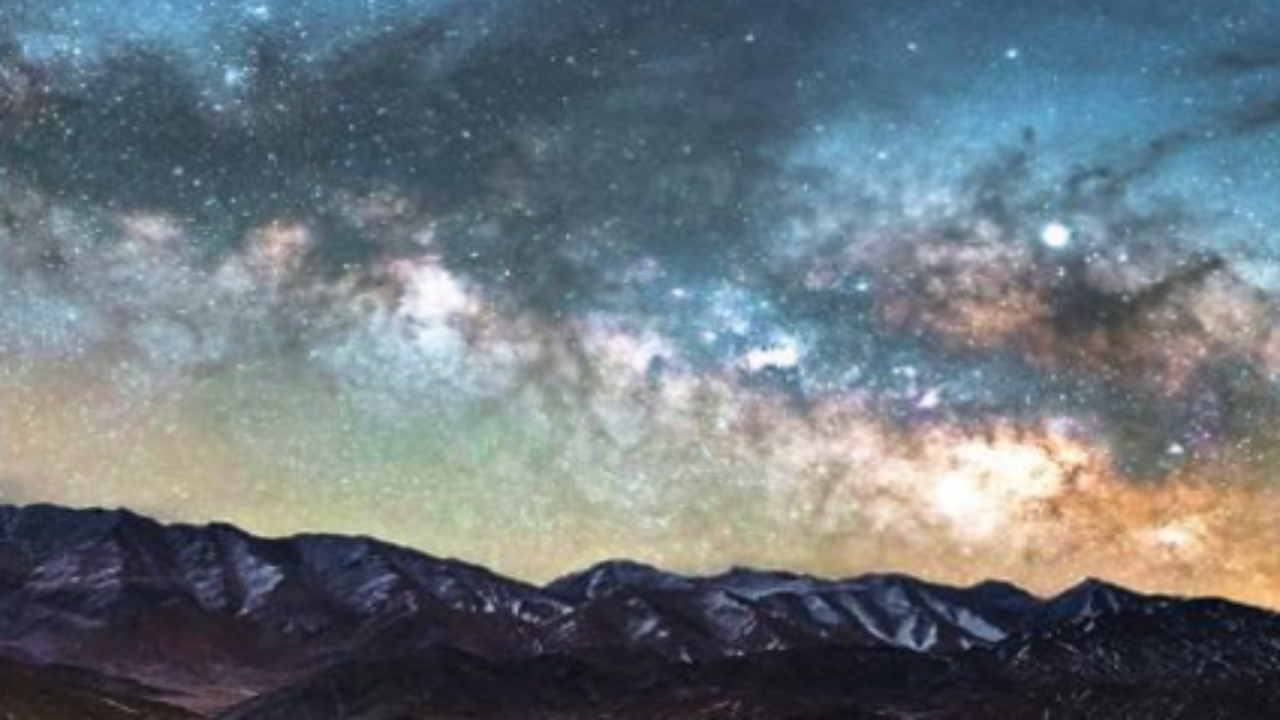India
India’s first stargazing site for tourists ready in Ladakh | India News

[ad_1]
Come summer, India’s first ‘dark sky reserve’ or night sky sanctuary will welcome you. The reserve lies at an elevation of 4,500m above sea level in a cluster of six hamlets that form Han le village inside the Changthang Cold Desert Wildlife Sanctuary in southwestern Ladakh.
The Hanle reserve is located around the Indian Astronomical Observatory (IAO) of the Indian Institute of Astrophysics (IIA) spread over 1,073 sq km. It is one of the highest places in the world for observing celestial bodies and collecting scientific data about the universe.
Although professional and amateur astron omers have been organising treks to secluded areas to observe the night sky, the Hanle reserve is unique because it not only promotes the eco-friendly activity of astrotourism but also aims to reduce artificial light pollution for the purposes of wildlife conservation, spreading awareness and education about astronomy, and strengthening scientific research.
Places that have little light pollution compared with urban, peri-urban, and village landscapes are ideal for night sky observation. That’s why the Ladakh UT administration had on Dece mber 1, 2022 notified Hanle as India’s first dark sky reserve. The decision is likely to benefit local communities with additional income and help in the conservation ofcrepuscular wild animals (mammals active at dawn and dusk). The formal notification will require certification from international agencies, such as Starlight Foundation and International Dark-Sky Association. Globally, there are only 20 such certified reserves and 16 sanctuaries, with most of them located in Europe. These include Alpes Azur Mercantour (France), Cranborne Chase (England), Ce ntral Idaho (US), Rhon (Germany), Kerry (Ireland) and Aoraki Mackenzie (New Zealand).
Dorje Angchuk, engineer incharge at the Hanle IAO, said, “We have already applied to the g lobal certification bodies. It may take 2-3 years. Nevertheless, Hanle has been a site for astronomical research since the setting up of the observatory in 2000. ”
Asked whether the facilities required fo r astrotourism have been set up, the chief wildlife warden of Ladakh UT, Sajjad Hussain Mufti, said, “The department of wildlife protection has procured 18 community telescopes and IIA has provided training to 23 community members of the Hanle village cluster. These community telescopes havebeen installed at the homestays of the beneficiaries. ”
Angchuk confirmed: “We have already trained villagers as astronomy ambassadors and handed over 18 of 24 telescopes. They know how to use minimum light, whenever and wherever it is needed. This will make the entire area light pollutionfree – the best suited for astro-tourism and studies of celestial bodies. ”
Mufti told TOI the department would also be installing one advanced telescope for the common observatory near the IAO.
Regarding the best time for astro-tourism in Hanle village, Mufti said, “Hanle has clear skies throughout the year. However, enthusiasts may mostly prefer April-Septem ber because of warmer temperatures. In winter, people come to Hanle to spot elusive wildlife, such as snow leopard, Pallas’s cat, black-necked crane, etc. ”
The project came to life through collaboration between the Ladakh administration, Ladakh Autonomous Hill Development Council, and IIA, and is being spearheaded by the UT’s department of wildlife protection, with support from the Central government, UNDP and Global Environment Facility (GEF) through their joint SECURE Himalaya Project.
What is light pollution?
At night, light from homes and streets reflects off Earth’s surface, leading to a constant ‘haze’ that makes celestial bodies hard to see. This is most noticeable in urban environments where even bright celestial bodies are barely visible to the naked eye.
What makes hanle a good dark sky reserve?
Hanle has several natural advantages for observing celestial bodies. It lies in Ladakh, a cold desert with minimal atmospheric moisture, so light rays from celestial bodies bend less in its air. This makes capturing sharp images – through the naked eye, telescopes and cameras – easier. Equally important is the extremely low light pollution due to Hanle’s sparse population – there were just 1,879 residents at the time of the 2011 Census.
How will artificial light be managed?
The Indian Institute of Astrophysics has a light management plan that covers procurement, distribution, and installation of equipment to reduce and control light pollution in Hanle. It’ll happen through the use of warm-coloured lights, lamp shades, and curtains. The procurement has already been completed and installation is under way in the public areas and residences of the village.
How will it aid wildlife conservation?
Hanle and its surroundings are home to several elusive wild animals and birds, including Ladakh’s state animal, snow leopard, and its state bird, the black-necked crane. Many of these animals, including the snow leopard, Eurasian lynx and Pallas’s cat, are crepuscular in nature (active at dawn and dusk). Light pollution can disturb their biological clock and interfere with their behaviours related to migration, mating, foraging and sleep. Thus, darker environments will contribute to their conservation.
The Hanle reserve is located around the Indian Astronomical Observatory (IAO) of the Indian Institute of Astrophysics (IIA) spread over 1,073 sq km. It is one of the highest places in the world for observing celestial bodies and collecting scientific data about the universe.
Although professional and amateur astron omers have been organising treks to secluded areas to observe the night sky, the Hanle reserve is unique because it not only promotes the eco-friendly activity of astrotourism but also aims to reduce artificial light pollution for the purposes of wildlife conservation, spreading awareness and education about astronomy, and strengthening scientific research.
Places that have little light pollution compared with urban, peri-urban, and village landscapes are ideal for night sky observation. That’s why the Ladakh UT administration had on Dece mber 1, 2022 notified Hanle as India’s first dark sky reserve. The decision is likely to benefit local communities with additional income and help in the conservation ofcrepuscular wild animals (mammals active at dawn and dusk). The formal notification will require certification from international agencies, such as Starlight Foundation and International Dark-Sky Association. Globally, there are only 20 such certified reserves and 16 sanctuaries, with most of them located in Europe. These include Alpes Azur Mercantour (France), Cranborne Chase (England), Ce ntral Idaho (US), Rhon (Germany), Kerry (Ireland) and Aoraki Mackenzie (New Zealand).
Dorje Angchuk, engineer incharge at the Hanle IAO, said, “We have already applied to the g lobal certification bodies. It may take 2-3 years. Nevertheless, Hanle has been a site for astronomical research since the setting up of the observatory in 2000. ”
Asked whether the facilities required fo r astrotourism have been set up, the chief wildlife warden of Ladakh UT, Sajjad Hussain Mufti, said, “The department of wildlife protection has procured 18 community telescopes and IIA has provided training to 23 community members of the Hanle village cluster. These community telescopes havebeen installed at the homestays of the beneficiaries. ”
Angchuk confirmed: “We have already trained villagers as astronomy ambassadors and handed over 18 of 24 telescopes. They know how to use minimum light, whenever and wherever it is needed. This will make the entire area light pollutionfree – the best suited for astro-tourism and studies of celestial bodies. ”
Mufti told TOI the department would also be installing one advanced telescope for the common observatory near the IAO.
Regarding the best time for astro-tourism in Hanle village, Mufti said, “Hanle has clear skies throughout the year. However, enthusiasts may mostly prefer April-Septem ber because of warmer temperatures. In winter, people come to Hanle to spot elusive wildlife, such as snow leopard, Pallas’s cat, black-necked crane, etc. ”
The project came to life through collaboration between the Ladakh administration, Ladakh Autonomous Hill Development Council, and IIA, and is being spearheaded by the UT’s department of wildlife protection, with support from the Central government, UNDP and Global Environment Facility (GEF) through their joint SECURE Himalaya Project.
What is light pollution?
At night, light from homes and streets reflects off Earth’s surface, leading to a constant ‘haze’ that makes celestial bodies hard to see. This is most noticeable in urban environments where even bright celestial bodies are barely visible to the naked eye.
What makes hanle a good dark sky reserve?
Hanle has several natural advantages for observing celestial bodies. It lies in Ladakh, a cold desert with minimal atmospheric moisture, so light rays from celestial bodies bend less in its air. This makes capturing sharp images – through the naked eye, telescopes and cameras – easier. Equally important is the extremely low light pollution due to Hanle’s sparse population – there were just 1,879 residents at the time of the 2011 Census.
How will artificial light be managed?
The Indian Institute of Astrophysics has a light management plan that covers procurement, distribution, and installation of equipment to reduce and control light pollution in Hanle. It’ll happen through the use of warm-coloured lights, lamp shades, and curtains. The procurement has already been completed and installation is under way in the public areas and residences of the village.
How will it aid wildlife conservation?
Hanle and its surroundings are home to several elusive wild animals and birds, including Ladakh’s state animal, snow leopard, and its state bird, the black-necked crane. Many of these animals, including the snow leopard, Eurasian lynx and Pallas’s cat, are crepuscular in nature (active at dawn and dusk). Light pollution can disturb their biological clock and interfere with their behaviours related to migration, mating, foraging and sleep. Thus, darker environments will contribute to their conservation.
#Indias #stargazing #site #tourists #ready #Ladakh #India #News






